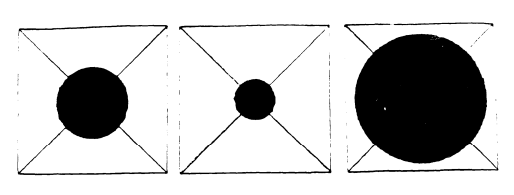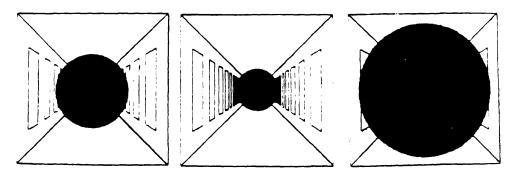
Herbert A. Simon proposed this problem and created an experiment, which is in detail described in the works of Kotovsky and Fallside (1988).
Following images and data comes from this source: (Kotovsky and Fallside, 1988).
The following image was presented to subjects.

Subjects were told either
or
This image was presented to subjects on an interactive computer screen along with a set of instructions (using the terminology of the group they were assigned to) and a form of a joystick to interact with those balls - to make them get bigger / smaller or come closer / go further. They were asked to solve an isomorph of Tower of Hanoi task, with rules restricting allowed ball changes. They were measured mainly on their solving speed.
As the stimulus and the task were the same for both groups, all differences between groups can be attributed solely to difference in mental representations of the task.
The mentalization of this problem significantly influenced the problem solving process that took place afterwards.
Subjects who were encouraged to mentally represent the ball change as a change in size (1) performed better at solving the given task (they were faster) and were able to (2) better transfer gained knowledge to the subsequent task, than subjects who mentally represented the ball change as a change in distance.
Mental representation of size change was observed to be more available than the distance representation.
Some subjects in the distance-representation group reported that they were using size mental representations contrary to their instructions. This was also observed in the Talk aloud measurements that were conducted. Additional tests were required to see if the stimulus is biased in availability towards size mental representation.
The following image was used (with added "window" frames)

and additional tests were conducted to disprove this bias. These tests exceed the relevance scope of this page and their full description can be found in the article mentioned at the top of this page. They do, however, show how minor stimulus / description changes can influence mental representations.
This was one of the first reported tasks that focused solely on mental representations. And although it was just a minor additional task in H. A. Simon's research, it paved the way for more in-depth research of mental representations and their effect on problem-solving process.